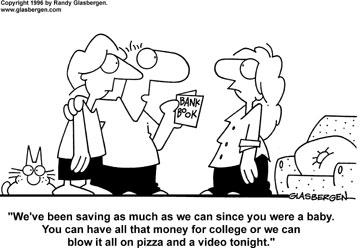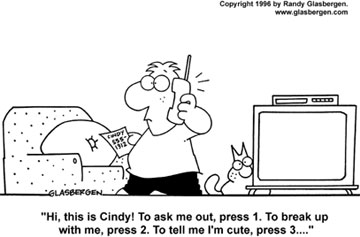 Look at the cartoon and think about these questions. Have you ever felt like these parents? How do the parents in the cartoon feel? The adolescent? What is this really saying about adolescents in our society?
Look at the cartoon and think about these questions. Have you ever felt like these parents? How do the parents in the cartoon feel? The adolescent? What is this really saying about adolescents in our society?
All parents experience a defining moment when their loving, sweet, affectionate child appears to have become a moody, bundle of raging hormones overnight. Parents who are prepared for these changes are more likely to relax and recognize that the child has moved into early adolescence.
While this transition is different for every child, early adolescence is usually defined as the period between 10 and 15 years of age. Early adolescence is the time between childhood and adolescence, while adolescence is the time between childhood and adulthood.
With one foot in childhood and the other in adolescence, the early adolescent faces a set of changes that can be scary and confusing. In no other period of an individual's life, except in infancy, are there so many changes in such a short period of time. Changes take place in the early adolescent's physical size and strength, thinking and reasoning, feelings and emotions, and relationships with family and friends. When parents understand why early adolescents behave the way they do, they can more easily relax and keep a sense of humor during this critical time of transition for their child.
Growing
While girls begin to mature approximately a year earlier than boys, both experience two related types of physical change in early adolescence: a major growth spurt and sexual development. For girls, the growth spurt typically starts at 10 years of age, peaks at 11 and is complete by 15. For boys, the growth spurt typically starts at 11, peaks at 13 and is complete by 15. Although not often noticed or discussed, early adolescents even experience changes in the sizes and functions of their eyes! In terms of sexual maturation, early adolescents develop what are called secondary sex characteristics. For girls, these include menstruation, breast development and body hair. For boys, these include development of testes, changes in vocal cord size resulting in a deepening of the voice, and body hair.
While there are some very easily recognized stages in early adolescence, each individual follows a unique path to adult physical maturity. Some are referred to as early developers and some as late developers. Being early or late can be stressful for adolescents when compared to the timing of the development of their friends. Adults need to remind early adolescents that by 16 or 17 years of age, the differences in development due to timing will have leveled off.
Thinking
As individuals move from childhood through adolescence they move from concrete to abstract thinkers. Concrete thinkers see issues as only "yes" or "no" or "black" and "white." They become frustrated when given problems or moral dilemmas with multiple solutions or no single correct answer. Abstract thinkers can see multiple ways of addressing a problem, enjoy considering "what-if" questions, and can imagine outcomes in the future.
Feeling
Early adolescents experience intense and unstable feelings. At least in part because of changes in hormones, they bounce from being silly, happy and exuberant to withdrawn, grouchy and sad. They feel embarrassed very easily and are overly concerned with how they look. They are most concerned about weight, skin, height and overall body shape.
Adults assume that early adolescents feel positive when they are alone in their rooms listening to music or simply daydreaming. However, when researchers have asked adolescents to describe their feelings when they are alone, the results show that they feel sad, overwhelmed, depressed and lonely. They may be alone but they are replaying many of the events of the day in their minds and being critical about how they acted and what they said. They may be reviewing over and over again what they said to the cute boy or girl who sits next to them in class. Or they may be trying to determine why a friend said a particular sentence or phrase to them. The more they worry about these events, the more depressed they become. They have not developed the thick skin that allows adults to dismiss trivial and less meaningful events in their lives.
Relating
The topics above (growing, thinking, and feeling) are all involved in how early adolescents feel about themselves and the kinds of relationships they have with the people around them. Relationships with friends become extremely important to the early adolescent because friends provide a sounding board for receiving support from others who are experiencing the same life stage. Friends are listened to for advice about parents, clothes, activities, music and boyfriends or girlfriends. Friendships may be developed through involvement in schools, communities or church activities. Sports may serve as a way to meet and gain respect from friends.
Early adolescents often feel nervous and anxious about their newly found interest in the opposite gender and prefer to hang out in groups. While early adolescents may assert their independence in their choices of friends, clothes, music, etc., they still need to feel that their parents are loving, supportive and available to talk to. One mother wrote:
"My 12-year-old son is in a stage of contradictions. He says: ‘take me to the mall but don't let any of my friends see you drop me off'…‘I really want to go on the family trip but I will miss my friends a lot'…‘I need hugs from my mom and dad but only when no one else is around'."
Research has shown that adolescents' greatest fear is losing their parents. When early adolescents were asked to write about how they feel about their mothers, the results showed that:
- Mothers were still the most important people in their lives
- Arguments with mothers were considered "normal" for adolescents and were quickly forgotten
- Mothers were seen as a source of comfort and support
The following quotes show the complex but positive feelings these ninth-grade adolescents had for their mothers.
- "I love my mother more than anything in the world."
- "My mother and I get along pretty well. Sometimes we fight but who doesn't fight with their mom."
- "I don't know what I would do without my mother."
- "I love my mother very much--we went shopping Saturday and she bought me some new clothes."
- "I still love my mom. Even though she doesn't want me to get a motorcycle license till I'm 16."
- "Although me and my mother sometimes get into fights, she helped me through my sickness yesterday and I'm glad I have her."
- "Some days my mom would be pretty cool, on other days she would be terrible. Right now she is okay."
- "She's good to me but she makes me mad a lot so I don't know exactly how I feel but I know it is positive."
- "My mom has been on my case a lot lately. I love her but I wish she would chill out."
 Look at the cartoon and think about how it shows the adolescent growing, thinking, feeling and relating.
Look at the cartoon and think about how it shows the adolescent growing, thinking, feeling and relating.
Tips for parents
Even when it seems to become more difficult to raise an early adolescent — when arguments increase about clothes, friends, music, etc. — parents need to remember a few simple facts.
- Your child may not admit it, but you are the most important person in his or her life
- Your ability to keep your "cool" and sense of humor will go a long may to reduce the stress in your relationship with your early adolescent
- Your child's annoying or frustrating behaviors are normal and will pass because underneath the spiked hair, baggy pants or unusual jewelry is an individual who will blossom into a mature, caring adult
- Your home can be child's "safe place" where he or she feels comfortable, calm, accepted and free to express his or her opinions
- Your child will grow up quickly. Make the most of the early adolescent stage by recognizing that your child will never be this age again
Judy Ford wrote a book on how to love your teenager, even when it seems impossible. She divided her book into three themes: serenity, spirit and security. In the chapter on serenity she recommends:
- Laugh about inconsistencies in your teen's behavior
- Be still and smile
- Willingly make up…decide to forgive your teen when he or she has hurt you
In the chapter on spirit she recommends:
- Take every opportunity to hang out together
- Try the playful approach… know when to lighten up
- Show wholehearted interest without taking over
In the chapter on security she recommends:
- Believe in them totally
- Negotiate…negotiate…negotiate
- Bravely let go
References
- Ames, N. L. (1994). Changing Middle Schools: How to Make Schools Work for Young Adolescents, Jossey-Bass: San Francisco.
- Benson, P. L. (1997). All Kids are Our Kids: What Communities Must Do to Raise Caring and Responsible Children and Adolescents, Jossey-Bass: San Francisco.
- Carnegie Council on Adolescent Development (1995). Great Transitions: Preparing Adolescents for a New Century, Carnegie Corporation of New York: NY.
- Espeland, P. (2001). Succeed Every Day: Daily Readings for Teens, Free Spirit Publishing: Minneapolis, MN.
- Ford, J. (1996). Wonderful Ways to Love a Teen…Even When It Seems Impossible. Conari Press: Berkeley, CA.
- Hargreaves, A., Earl, L., and Ryan, J. (1996). Schooling for Change: Reinventing Education for Early Adolescents, Falmer Press: Washington, DC.
- Jackson, A., and Davis, G. A. (2000). Turning Points 2000: Educating Adolescents in the 21st Century, Teachers College Press: NY.